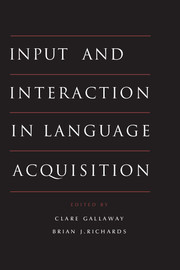Book contents
- Frontmatter
- Contents
- List of figures
- List of tables
- List of contributors
- Preface
- Introduction
- Part I General issues
- Part II Specific aspects of input and interaction
- Part III Types of language learner
- 8 Language interaction with atypical language learners
- 9 Interaction and childhood deafness
- 10 Input and interaction in second language acquisition
- Conclusion
- References
- Author index
- Subject index
9 - Interaction and childhood deafness
Published online by Cambridge University Press: 05 June 2012
- Frontmatter
- Contents
- List of figures
- List of tables
- List of contributors
- Preface
- Introduction
- Part I General issues
- Part II Specific aspects of input and interaction
- Part III Types of language learner
- 8 Language interaction with atypical language learners
- 9 Interaction and childhood deafness
- 10 Input and interaction in second language acquisition
- Conclusion
- References
- Author index
- Subject index
Summary
Introduction
The study of language acquisition in deaf children is one in which questions of input take on a unique importance. Deaf children should not be viewed as exclusively of a monolingual background and as potential learners of the spoken language only. Between 5 and 10 percent are born to deaf parents, and if sign language is used in the home, such children may then acquire it as their first language. The majority of children with a prelingual hearing loss, however, are born to hearing parents. These parents may be using only spoken language with their children, or they may be learning and using a sign language or perhaps a spoken language in conjunction with some manual support system such as Cued Speech or Signed English. In other families, deaf children of deaf parents and deaf children of hearing parents may be learning language in a bilingual setting. Finally, other sociolinguistic situations exist, for example, when deaf children are members of a minority linguistic community.
A major theme of this chapter is the necessity of drawing a distinction between input by adults, intake received by deaf children, and their own consequent output. Specifying features of parents’ language does not define what language or languages the child may be able to perceive or ultimately to develop.
- Type
- Chapter
- Information
- Input and Interaction in Language Acquisition , pp. 197 - 218Publisher: Cambridge University PressPrint publication year: 1994
- 15
- Cited by



